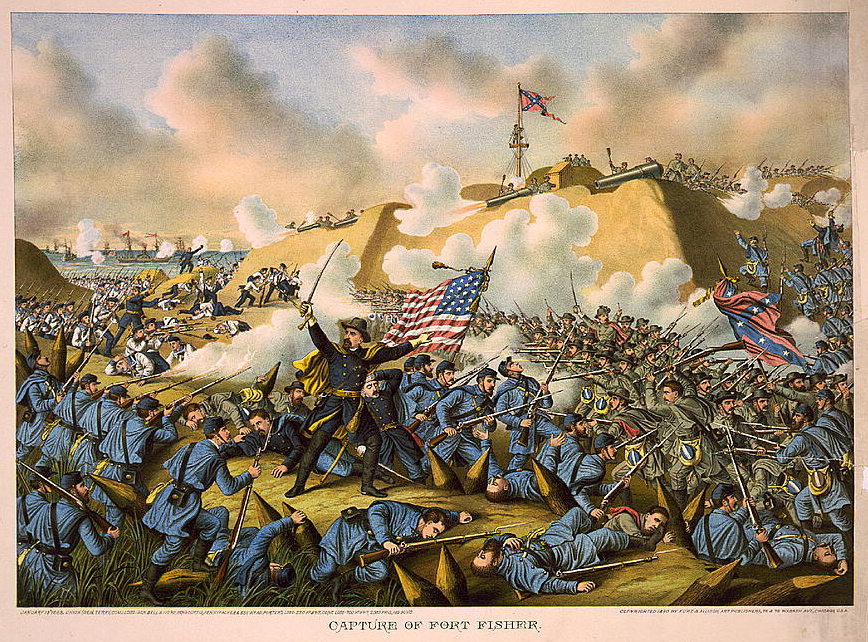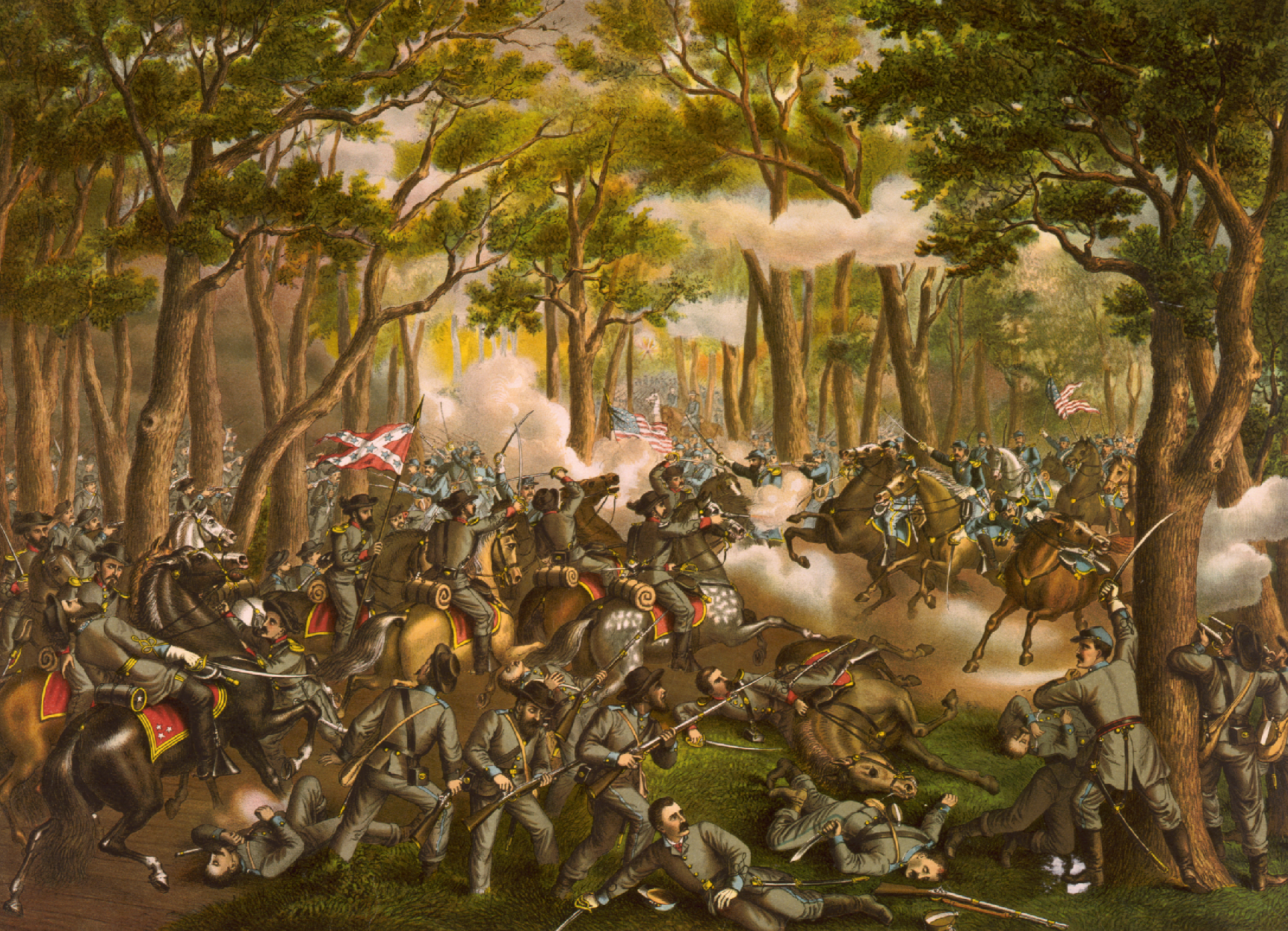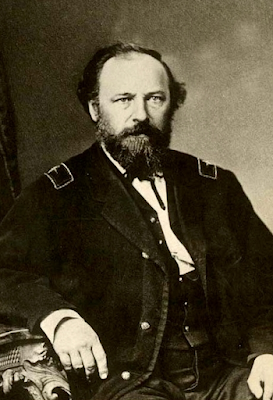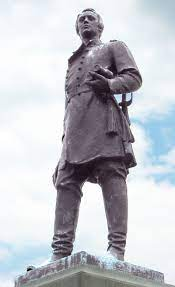Mid-1863 saw several battles and campaigns that put military momentum solidly with the Union. Many consider this the turning of the tide, though it can be argued that the Union was once on the verge of winning in mid-1862 and the Confederacy actually made some comebacks in 1864.
Battle of Chancellorsville
After restoring morale and efficiency within the Army of the Potomac, General Joseph Hooker attempted a flanking movement across the Rappahannock against Lee’s Confederate forces. He actually placed the heavily outnumbered Lee in a tricky situation near Chancellorsville at the start of May 1863. On May 2 General “Stonewall” Jackson executed an incredible flank march that routed the Union right. Jackson was hit by friendly fire (he would actually die of pneumonia instead of his wounds) while Hooker suffered a concussion that affected his judgment. The next day the Confederates were able to drive the Federals back across the river. Despite accomplishing one of his most celebrated victories, Lee believed that he could not afford any more such bloody battles.
Kurz focuses on the events of May 2. He shows the Union troops withdrawing towards the background, where artillery covers their retreat. The centerpiece, however, is the wounded Jackson. It looks like he’s been hit by a lucky enemy bullet rather than friendly fire. All the Confederate soldiers are ahead of him attacking the Federals. Also, Jackson was hit at night while reconnoitering ahead of his lines, not during the height of the daylight action. Obviously Kurz wanted to show the infamous shooting while still displaying a battle vista.
Battle of Champion Hills
This is the first of two lithographs covering the Vicksburg Campaign. After a string of failures to take the last Rebel bastion on the Mississippi River, General Ulysses S. Grant finally put together his magnum opus. With the help of the Navy he was able to quickly slip his army from north to south of Vicksburg and cross back over the Mississippi (into the state of the same name). What followed was a string of battles where Grant defeated disunified Confederate forces. Champion Hill (called Champion Hills for the lithograph) was one of the more crucial encounters. On May 16 Grant struck General Louis Pemberton’s main force at the considerable height of Champion Hill. The Federals first flanked and then smashed through the Confederate lines, taking the nearby crossroads. The battle forced Pemberton towards Vicksburg with no escape route, ensuring a siege.
I am not as acquainted with this battle so I might miss a couple inaccuracies or neat references to real locations and figures. The Confederates in the foreground are notably more diverse in their clothing, especially the prisoners. Those on the right in front of the formidable Champion Hill sport a battle flag with inverted colors for St. Andrew’s Cross and the stars. The mounted figure leading his men on with his hat is General John Logan, who got into the Confederates’ flank. Logan was a political general from Illinois who enjoyed more success than others of his kind, possibly because his aggression worked well with Grant and Sherman’s battle plans.
The Battle of Gettysburg

The bloodiest (and almost largest) battle on North American soil, Gettysburg occurred from July 1 to 3. Lee, looking for a quick blow to end the war, invaded the North for the second time. Through a series of mistakes and circumstances, the two sides blindly struck each other north of the crossroads town of Gettysburg, Pennsylvania. On the first day Confederates pushed the Federals south through the town. The Army of the Potomac, now under General George Meade, took the heights south of town and narrowly repulsed a series of attacks on the second day. The third day cemented the Confederate defeat when Lee’s major assault on the Union center turned into a bloodbath. This was the first and perhaps only massive tactical defeat for Lee.
As with most artists who choose one part of the battle, Kurz focuses on Pickett’s Charge, the ill-devised July 3 assault on Cemetery Ridge. This is definitely one of his more cluttered works and I have to say not as striking. Masses of men from both sides advance from the sides of the lithograph. A wrecked Union battery shows the work of the incredible pre-assault bombardment (which was actually ineffective thanks to untested ordnance). A clump of Confederate prisoners are escorted off while a thick line of men snakes over the stone wall. The fence along Emmitsburg Road can be made out behind a shell-struck group of Rebels. If the dying officer on horseback is supposed to be General Lewis Armistead, Kurz forgot he was on foot for the whole charge.
Siege of Vicksburg

The Siege of Vicksburg lasted from May 18 to July 4. Grant made several attempts to take the city by force, all of which failed. Bombardments, though terrifying to the civilians, also did not wear down Confederate resistance. It was starvation that finally forced the loss of the city. Pemberton was supposed to get relief from General Joseph Johnston to the east, but Johnston dallied. Relief attempts from the Trans-Mississippi came too late and ended in defeat anyways. On July 3 Pemberton opened up talks of surrender, which were finalized the following day. Combined with the defeat at Gettysburg, this was a disaster for the Confederacy, giving the Union unrestricted access along the Mississippi River.
This is one of the more placid works, though there is still some action. Shells burst among the entrenchments and Union gunboats patrol the Mississippi River. For once some of the soldiers are shown not fighting. Many are actually lounging about, in great contrast to all the activity on the left side of the lithograph. In the right foreground an officer directs Grant’s attention (to what we don’t know). A Confederate party carrying a white flag emerges from the trees. It could be a flag of surrender, but the tiny red cross in one corner indicates it may be something else.



























